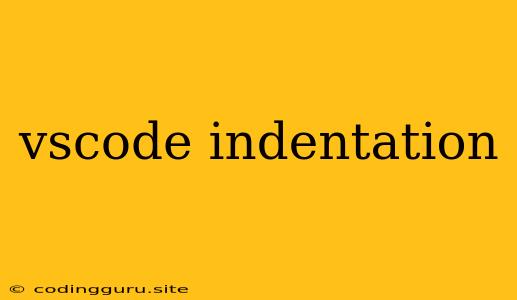VS Code Indentation: Mastering the Art of Code Formatting
VS Code, the ubiquitous code editor, offers an intuitive and powerful interface for developers. However, one aspect that often sparks debate and even frustration is indentation. While seemingly a minor detail, consistent indentation plays a crucial role in code readability, maintainability, and ultimately, the sanity of every developer. This article delves into the intricacies of VS Code indentation, exploring its settings, customization, and best practices.
What is Indentation and Why is it Important?
Indentation refers to the spaces or tabs used to visually structure code, making it easy to understand the hierarchy and flow of logic. Imagine reading a book without any paragraphs or spacing—it would be a daunting and confusing experience. Similarly, poorly indented code can make it a nightmare to navigate, debug, and comprehend.
How does VS Code handle indentation?
VS Code employs a smart indentation system that typically tries to infer your preferred style based on the programming language you're working with. By default, it uses spaces for indentation. However, the beauty of VS Code lies in its extensive customization capabilities, allowing you to fine-tune its indentation behavior to match your personal coding preferences.
Understanding the Settings
The heart of VS Code indentation control resides in its settings, accessible through File > Preferences > Settings (or Code > Preferences > Settings on macOS). Here, you'll find several key options related to indentation:
- "editor.indentSize": This setting determines the number of spaces used for a single indentation level. The default is 2 spaces.
- "editor.tabSize": This setting controls the number of spaces a tab character represents. It's typically set to the same value as "indentSize" to ensure consistent indentation, but you can adjust it if needed.
- "editor.insertSpaces": This is a crucial setting. If set to "true" (the default), VS Code will insert spaces when you press the Tab key. If set to "false," it will use actual tab characters instead.
- "editor.detectIndentation": This setting allows VS Code to automatically detect the indentation style used in an existing file, adhering to its conventions.
Customizing Indentation Rules
VS Code supports a powerful feature called "editor.formatOnSave". When enabled, your code will be automatically formatted whenever you save a file, ensuring consistency. However, VS Code relies on language-specific formatters for this. For popular languages like Python and JavaScript, built-in formatters are often available. For other languages, you may need to install extensions that provide formatting capabilities.
A Tale of Spaces vs. Tabs
The great debate: spaces vs. tabs. This has been a long-standing discussion in the developer community, with strong opinions on both sides. The "spaces" camp emphasizes consistency and predictability, while the "tabs" camp champions flexibility and adaptability. VS Code allows you to choose your weapon, but it's generally recommended to stick to spaces for easier collaboration and compatibility across various editors and platforms.
Best Practices
- Consistency is King: Choose a consistent indentation style (spaces or tabs) and stick with it throughout your project.
- Use a Consistent Indentation Level: Use a fixed number of spaces or tabs (usually 2 or 4) for each indentation level.
- Understand Language Conventions: Different programming languages have their own conventions. Research the common practices for the languages you use to ensure your code adheres to industry standards.
- Leverage Formatters: Utilize automatic formatters to ensure consistent indentation and code style.
Example
Here's an example of how inconsistent indentation can make code hard to read:
def greet(name):
print("Hello", name)
print("Welcome!")
Compare this to the same code with proper indentation:
def greet(name):
print("Hello", name)
print("Welcome!")
Troubleshooting
- Indentation Conflicts: If you encounter issues with inconsistent indentation, double-check your settings, especially "editor.insertSpaces" and "editor.detectIndentation".
- Extension Conflicts: Some extensions might override VS Code's default indentation settings. If you're experiencing unexpected indentation behavior, temporarily disable any recently installed extensions to see if they're the culprit.
- Language Specific Settings: Certain languages may have their own settings within VS Code. For example, Python has a setting for "python.linting.pylintEnabled" that controls the use of the Pylint linter, which includes indentation checking.
Conclusion
Mastering VS Code indentation is an essential skill for every developer. By understanding the available settings, customizing them to your preferences, and adopting best practices, you can write code that's not only functional but also visually appealing, maintainable, and easy to work with. Remember, a clean and well-structured codebase is a happy developer's playground.
